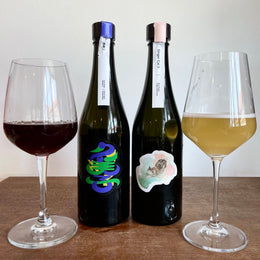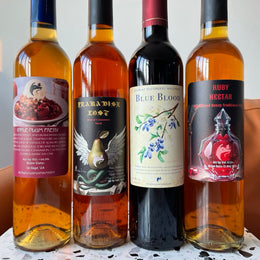
So, what exactly is cola?
If we’re talking about the OG cola, it refers to the 1866 recipe by pharmacist John S. Pemberton, who ran his own pharmacy. What Pemberton created was a tonic syrup, which originally contained cocaine from coca leaves, caffeine from kola nuts, which he sold to soda fountains. His bookkeeper, Frank Robinson, penned the name “Coca-Cola”, referencing the names of both botanicals that were originally used in the recipe. According to Coca Cola, Dr Pemberton first brought his syrup to Jacob's Pharmacy, where the beverage had its rise to fame.
![]()
Source: Coca-Cola
The drink was known to be “delicious and refreshing”, and became a sensation amongst the people (maybe… cocaine played a role?). Soon enough, cocaine from coca leaves were removed from the official recipe in 1903. Kola nuts, which are used amongst communities in Western Africa as both a stimulant and folk medicine, was only removed from the recipe in 2016 according to Coca Cola.

![]()
The evolution of bottle shapes since its inception. Source: Coca-Cola
It’s a bit unsure what the flavourings were in the original cola syrup as the recipe is said to be under lock and key, but it sheds light on how cola isn’t technically a soft drink but a syrup that gets mixed into soda water to create the beverage. Apparently, there’s some places in USA that still does it ol’ fashioned.

Lexington Candy Shop is one of the famous places in NYC that does it old school. Source: Drew (Youtube)
Nevertheless, homemade cola has had a bit of a boom in recent years - where the main flavour suspects are citrus peels (lemon, lime and orange), cinnamon, vanilla, and some sort of acid. There are variations to the recipe, with some recipes including nutmeg, and there’s the debate of adding caramel colour versus caramelising the sugar to give the beverage its dark colour, but the general consensus is that cola should be a citrusy, sweet beverage with some hint of herbaceousness and spice.

Some recipes also call for the addition of gum arabica for a richer mouthfeel. Source: The Educated Barfly (Youtube)
Tomo Cola: Cola ain’t all that bad!
Yamato Cola is a product from the Tomo Cola brand, hailing from the Soni Village in Nara Prefecture. The brand has its origins in 2018, where it aimed to explore the unique plants and herbs native to Japan.

Souce: Tomocola.com
Interestingly, the brand also aimed to shatter the “unhealthy image” that cola has had garnered over the years - in a sense, cola was originally a medicinal tonic that utilised spices and herbs from all over the world. Instead, Tomo Cola localises the herbs and spices to what is found in the “fields and mountains all over the country”.

A video taken featuring Tomo Cola. Souce: Nara Travel Guide (Facebook)
As of date, there have been five craft cola syrups under the Tomo Cola brand - some reflecting the prefecture’s unique botanicals. The first craft cola syrup was the Kumamoto Craft Cola - developed in 2019. The cola syrup, which features the abundance of citrus fruits of the prefecture, is now produced under Hanauta Kajitsu, a citrus farm in Kumamoto Prefecture.
![]()
Kumamoto Cola. Source: Tomo Cola
Yamato Cola
What’s the special feature of this cola, then? This cola was developed from August 2020 to April 2021, the most recent of colas to be released under Tomo Cola. The name “Yamato” comes from two special botanicals: the Yamato Tachibana (tachibana orange) and Kihada (amur cork-tree).
![]()
Source: Tomo Cola
The tachibana orange, once touted as the “fruit of immortality”, has fallen a bit on the wayside. The citrus fruit has had centuries of history in Japan, and is found along the coasts of warmer regions such as Mie Prefecture. As the tree retained its leaves in winter, it has also served as a symbol of longevity. However, in recent years, it has became increasingly difficult to harvest fruits from this endangered tree species. A farmer in Nara has started the Nara Tachibana project - aimed at reviving and cultivating the tree more effectively.

Source: Watobi.jp
(On a side note, Yamato was the old name given to Nara Prefecture).
Kihada (キハダ), more commonly known as the amur cork-tree, is often used in medicine in Korea, China and Japan. The Ainu people, a people indigenous to Hokkaido, used the plant as a painkiller. The fruit of the tree is used in this syrup, though other parts of the plant has medicinal uses as well.

キハダの実 (Kihada no Mi). Souce: hino-seiyaku.com
Another botanical of interest is the Yamato Touki as well, or, angelica acutiloba. A species of angelica root, the herb touki is said to be endemic to Japan, but has been cultivated in other asian countries such as Korea, Taiwan and China. This herb is often used in kanpo (Japanese adoption of traditional Chinese medicine), and is also commonly nicknamed as the Japanese angelica root. The Yamato designation refers to the herb being grown within Nara Prefecture, and the kanji 当帰 literally means “recover back to health”.

Yamato Touki 大和当帰. Source: Wakanyaku
Apart from the above three ingredients are all produced and harvested in Nara prefecture, there are more than 15 ingredients in this syrup. The other ingredients include:
Lemon レモン, kibi sugarきび砂糖 (light brown sugar), cloves クローブ, allspice オールスパイス, cardamom カルダモン, cinnamon シナモン, kola nuts コーラナッツ, and other spices.
Here’s what’s written on the bottle label, and a quick translation (my personal attempt at translation - please correct me if there are mistakes!).

The back of the Yamato Cola bottle.
I was given this as a souvenir from relatives who came back from Nara. They thought that this dark concoction was some sort of booze - turns out, it’s a cola syrup. It was perfect for the hot afternoon, and I figured it’s time to go dry for at least one of out seven days of the week.
Yamato Cola 大和クラフトコーラ 0% ABV – Review

Nose: A powerful, profound nutmeg aroma that is rounded off by a bit of ground cloves. There is a deep, herbal dried fruit fragrance that is a mix between dehydrated lemons and seville orange skins.
Taste: The palate reminds me of cough syrup, the likes of Woods or Nim Jiom Pei Pa Koa. The sweetness tends towards autumn fruits, such as a slightly under ripe persimmon that has retained some of its tannic bitterness. There is a woody-herbal-bitterness combo that reminds me of chewing on mugwort leaves and angelica roots at the same time.

Finish: The tingling of mace is quite profound, leaving behind an astringent, numbing sensation on the palate. There is a bit of warmth from cassia, as well as that fragrant, volatile woodiness from angostura bitters.
My Rating |
👴Sit back on your rocking chair and relax - this is what this drink reminds me of. An elder who is wise and has lots of wisdom to share - while keeping it fun still. |
Is it a cola cola? Uhmmm, not so much in my opinion. At least, when you think of Coca-Cola, Pepsi or RC Cola, this does not come close to it. I do get some of that orange, refreshing zestiness you come to associate with the aforementioned sodas, but definitely, the nutmeg, angostura and seville orange peel flavours are a lot more pronounced. On that note, if you followed the directions stated on the bottle (a 1:5 ratio between syrup and soda water), the sweetness may be a little lacking.
It’s more of a bittersweet, herbal soda that, if you so desire (and me having the palate of a septuagenarian) you can juzz up with a naughty dash or two of angostura bitters to invigorate that spicier, woodier flavours. Overall, a delicious and fun gift for a friend who may have been drinking a bit too much!

@vernoncelli







